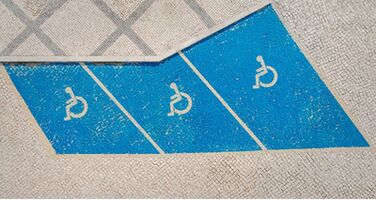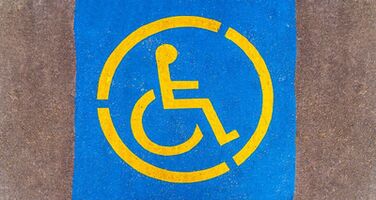
Tips for Displaying Your Handicap Placard Correctly in Maine
Maine, like every other U.S. state, has specific regulations for using disability parking tags (also known as placards). These tags help people with disabilities access designated parking spots that are closer to building entrances, making it easier to navigate public spaces. However, there are rules and guidelines about how these tags should be used and displayed, to ensure that only those who are eligible benefit from them. Misuse can result in fines or the revocation of the tag altogether.
This comprehensive guide provides tips on how to properly display your handicap placard in Maine, the importance of compliance, and answers to frequently asked questions about the process.
Introduction to Handicap Placards in Maine
Disability tags, also referred to as handicap placards, are issued by the state of ME to residents who qualify due to physical disabilities. These tags allow individuals to park in designated spaces, making it easier for them to access buildings and public facilities. For those who need them, these tags are invaluable in promoting independence and mobility.
However, having a disability tag also comes with responsibility. Improper use or failure to display it correctly can result in fines or other penalties. It’s essential to know how to properly use your tag, and this article will walk you through the process to ensure you're fully compliant with ME’s rules.
Eligibility Requirements for Disabled Permits
To qualify for a disability tag in ME, applicants must meet certain criteria. These can include:
- Inability to walk 200 feet without stopping to rest
- Use of portable oxygen
- Limited ability to walk due to an arthritic, neurological, or orthopedic condition
- A Class III or Class IV cardiac condition
- Lung disease, which restricts mobility due to severe breathing difficulties
Eligibility is determined by a licensed physician who certifies that an individual meets these criteria. Once eligibility is confirmed, the individual can apply for a disability tag from the Bureau of Motor Vehicles (BMV) in ME.
Different Types of Disabled Permits in Maine
ME offers two primary types of handicap permits:
Permanent Disability Tag: Issued to individuals with long-term or permanent disabilities. This tag typically needs to be renewed every four years but can be reissued upon renewal without needing additional certification from a physician unless otherwise specified.
Temporary Disability Tag: Designed for individuals with temporary disabilities, such as recovery from surgery or an injury. This tag is valid for up to six months and can be renewed once if necessary.
Both tags are issued free of charge and come with specific instructions on how they should be displayed in the vehicle.
Steps to Apply for a Handicap Permit in Maine
Applying for a disability parking tag in ME is a straightforward process:
- Obtain a certification form from the Maine Bureau of Motor Vehicles (BMV).
- Have a licensed healthcare provider, such as a doctor or physician's assistant, complete the medical certification section.
- Submit the completed form to the BMV, either by mail or in person at a local branch.
Once your application is approved, you will receive your tag or plates in the mail.
Where to Place Your Disabled Permit in Your Vehicle
Proper display of the disability tag is crucial to avoid fines and ensure that it is used correctly. ME law requires the tag to be hung from the vehicle's rearview mirror whenever the vehicle is parked in a designated disability space.
Here are a few key points to remember:
- The tag should be hung facing outward, so the expiration date and other information can be easily read by law enforcement officers or parking officials.
- Make sure to remove the tag when driving. Leaving it hanging while driving can obstruct your view, which is a safety concern and may violate traffic laws.
- If your vehicle doesn’t have a rearview mirror (for example, if you drive a motorcycle or another type of vehicle), place the tag on the dashboard in a visible location.
When and Where You Can Use Your Handicap Placard
Disability tags can be used in a variety of places, but they come with limitations:
- Designated Parking Spaces: The tag allows you to park in spaces reserved for individuals with disabilities, typically marked by a blue sign featuring the wheelchair symbol.
- Metered Parking: In some cases, individuals with a disability tag are exempt from paying at parking meters, but this may vary by location.
- Public vs. Private Spaces: Public parking lots, such as those at government buildings, malls, or grocery stores, will typically have designated spaces. However, private businesses may have different rules. Always check signage to ensure that your tag is valid in the lot where you're parking.
It's also important to note that the tag is only valid when the person to whom it is issued is in the vehicle. Using the tag when the person with a disability is not present is considered misuse and may result in penalties.
Best Practices for Proper Display of Your Handicap Placard
Following these best practices will ensure that your disability tag is always properly displayed:
- Consistency: Make it a habit to always hang your tag when parking in a designated spot. Forgetting to do so can result in a citation, even if you are legally allowed to park there.
- Visibility: Ensure that the entire tag is visible from outside the vehicle. Do not cover any part of the tag with objects like paper or cloth, and do not place it upside down.
- Safe Removal: Take down the tag when you're driving. Not only can leaving it up be a safety risk, but it also ensures that you don't damage or wear out the tag prematurely.
- Maintain the Tag: Over time, the print on the tag might fade, or the tag itself might become worn. If this happens, it’s important to request a replacement to avoid any potential issues.
Tips for Displaying Your Handicap Placard Correctly in Maine
1. Hang the Tag on the Rearview Mirror
The most common and legally acceptable way to display your Maine disabled permit is to hang it from the rearview mirror of your vehicle. Here’s how to do it:
- Ensure the front side of the tag is visible, showing the expiration date and the permit number.
- Hang the tag only when the vehicle is parked. Remove it when driving to avoid distractions or obstruction of the driver’s view.
- The tag should hang freely without any obstruction, making it easy to read from outside the vehicle.
2. Use a Placard Holder for Better Protection
Investing in a permit holder can help protect your disability tag from wear and tear. The holders come in various designs, typically with a plastic pouch and a hook for easy hanging. Using a holder not only keeps your tag intact but also makes it easier to hang and remove as needed. Consider the following options when choosing a holder:
- Clear Plastic Holders: Offer visibility and protection.
- Anti-Glare Holders: Reduce glare and improve readability in bright sunlight.
- Velcro Attachments: These help in easily attaching and removing the tag without bending it.
3. Display the Tag in a Visible Location When Not Using the Rearview Mirror
In certain situations, such as when driving a motorcycle or if your rearview mirror is obstructed, you might need an alternative way to display your disability tag. In such cases:
- Place the tag on the dashboard: Ensure it is flat and the permit number and expiration date are clearly visible through the windshield.
- Avoid placing it on the seats or floor: Tags left in these locations are often difficult to see and can result in fines.
4. Always Remove the Tag When Driving
One of the most common mistakes drivers make is leaving the disability tag hanging from the rearview mirror while driving. This is considered a traffic violation in ME, as it can obstruct the driver’s view and cause a safety hazard. Always remove the tag before starting your vehicle and store it safely until you reach your next destination.
5. Avoid Sharing or Lending Your Disability Tag
Disability tags are issued specifically for the person whose name is on the tag, not for the vehicle itself. Therefore:
- Do not share or lend your tag to family members or friends, even if they are running errands for you.
- Misuse of a disability tag is a serious offense in ME and can result in the revocation of your tag and substantial fines.
6. Keep Your Tag Information Updated
It’s essential to keep your disability tag information up-to-date. If you have a temporary tag, keep track of the expiration date and reapply if necessary. For permanent tags, ensure that any changes in your personal information, such as a change of address, are updated with the BMV.
7. Use Anti-Theft Devices
Unfortunately, theft of disability tags is not uncommon. Thieves often steal these tags to misuse the disabled parking privileges. To prevent theft:
- Use anti-theft hooks or locking devices that make it harder to remove the tag from the rearview mirror.
- Consider marking your tag with a unique identifier, like your initials, which makes it less appealing for thieves.
8. Follow Local and State Regulations for Parking
Even with a disability tag, it’s important to follow all local parking regulations. In ME:
- Only park in designated spots marked with the international symbol of access.
- Do not park in “No Parking” zones or in spaces reserved for other purposes, such as fire lanes or loading zones.
- Pay attention to time restrictions in certain locations, as your tag does not exempt you from these rules unless specifically stated.
9. Use a Secondary Tag for Multiple Vehicles
If you frequently use more than one vehicle, consider applying for a secondary tag. This way, you won’t need to worry about transferring the tag between vehicles, which reduces the chances of forgetting or losing it.
10. Report a Lost or Stolen Tag Immediately
If your disability tag is lost or stolen, report it to the ME BMV immediately. This prevents unauthorized use and helps you get a replacement quickly. The process involves filling out the Application for Replacement form and providing any necessary documentation.
Common Mistakes in Displaying a Disabled Permit
Despite the straightforward guidelines, many people make simple mistakes when using their disability tags. Here are a few common errors:
- Forgetting to Hang the Tag: One of the most common mistakes is parking in a designated disability space and forgetting to display the tag. Even if you have a disability pass, failure to display it properly can lead to fines.
- Improper Placement: Hanging the pass on the wrong part of the vehicle, such as on the dashboard where it's not fully visible, can also lead to problems.
- Using the Tag When Not Required: Some people leave the tag hanging at all times. This can obscure the driver’s view and may cause distractions, which could lead to a traffic violation.
Maintaining and Replacing Your Disabled Permit
ME's disability tags have expiration dates, and it's crucial to ensure yours is current. The state typically issues permanent passes with a 4-year validity and temporary passes for 6 months.
To replace a lost, stolen, or damaged pass, contact the ME Bureau of Motor Vehicles (BMV). There’s no fee for replacing a pass, but you must submit a request form and explain the reason for the replacement. If your pass is expiring soon, you should start the renewal process a few months in advance to avoid any gap in your eligibility.
Penalties for Misusing a Handicap Placard in Maine
Misuse of a disability parking pass can lead to serious consequences in ME. The state enforces strict penalties to ensure that these spaces are reserved for individuals who genuinely need them.
Common forms of misuse include:
- Using a tag without the disabled person in the vehicle.
- Allowing someone else to use your tag.
- Parking in a disability space without a valid tag.
Penalties for misuse can range from fines to the suspension or revocation of the pass, depending on the severity of the offense. In addition to monetary penalties, repeat offenders may face criminal charges, and in some cases, the vehicle could be towed.
Tips for Visitors to Maine Using Handicap Permits
If you are visiting ME and possess a valid handicap placard from another state, it is recognized and can be used in ME. However, you must follow the same display rules as ME residents. Make sure your tag is clearly visible when parked in a designated space, and always remove it before driving.
How to Report Handicap Placard Misuse
If you witness someone misusing a disability tag, such as parking in an accessible space without the required tag or using someone else’s tag, you can report it to local law enforcement. In ME, law enforcement agencies take this issue seriously to ensure that parking spaces remain available for those who genuinely need them.
Most parking lots will have a posted number or method for reporting violations. Alternatively, you can call your local police department or the Bureau of Motor Vehicles to report the issue.
Benefits of Proper Disabled Permit Use
Using a disability tag correctly provides several benefits:
- Accessibility: It ensures you have access to parking spaces that make it easier to navigate public areas.
- Independence: For many individuals with disabilities, the ability to park closer to entrances enhances their independence and mobility.
- Protection from Fines: Following the rules ensures that you avoid unnecessary penalties and fines for improper display.
Proper use also ensures that these spaces remain available for others who need them, fostering a sense of community and respect for all individuals with disabilities.
Additional Resources and Support for Disabled Drivers
For more information or assistance with applying for or renewing a disability tag in ME, the following resources can be helpful:
- Maine Bureau of Motor Vehicles (BMV): The official state office where you can apply for, renew, or replace your tag.
- Disability Rights Maine: A non-profit organization that advocates for the rights of individuals with disabilities.
- Maine Department of Transportation: Provides information on parking regulations and accessibility services in public transportation.
These resources can help you navigate the process and ensure you have the support you need to maintain your mobility and independence.
Frequently Asked Questions (FAQs)
1. How do I apply for a disability parking tag in ME?
You need to fill out an application from the ME Bureau of Motor Vehicles, have your physician certify your disability, and submit the completed form to the BMV.
2. Where should I hang my disability tag?
You should hang the tag from your rearview mirror, facing outward, so that it is clearly visible to parking authorities.
3. Can I use my disability tag in other states?
Yes, ME recognizes disability tags from other states, and most states will recognize ME-issued tags. Be sure to follow the display rules of each state you visit.
4. What do I do if my pass is lost or stolen?
If your disability pass is lost or stolen, contact the ME Bureau of Motor Vehicles to request a replacement. You will need to provide an explanation for the loss or theft.
5. Can someone else use my disability pass?
No, the pass is only for use when the individual it is issued to is in the vehicle. Allowing someone else to use it is considered misuse and can lead to fines or the revocation of the pass.
6. What should I do if my disability tag expires?
You should renew your tag by submitting a renewal application to the Bureau of Motor Vehicles before the expiration date. Permanent tags are valid for four years, while temporary tags last six months.
Conclusion
Displaying your handicap placard correctly in Maine is not only a matter of following the law but also a way to ensure that accessible parking spaces are available to those who need them most. By understanding the regulations, maintaining your tag, and using it properly, you contribute to a more accessible and respectful community. Make sure to follow the guidelines provided, avoid common mistakes, and keep your tag up-to-date. By doing so, you ensure that you continue to enjoy the benefits of accessible parking while avoiding unnecessary fines or penalties.
.png)






